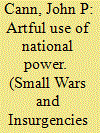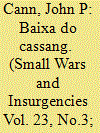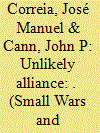|
|
|
Sort Order |
|
|
|
Items / Page
|
|
|
|
|
|
|
| Srl | Item |
| 1 |
ID:
103971


|
|
|
|
|
| Publication |
2011.
|
| Summary/Abstract |
In its colony of Angola, Portugal during its colonial wars (1961-1974) was able to exploit the economic dependence and divided population loyalties of its hostile neighbours the Congo and Zambia as well as the cleavages within the nationalist movements to prevent a crippling insurgency. The rulers of both countries were largely dependent on Angola for trade, and were eager to have the side effects of the robust Angolan economy with its 11% annual growth brush off on their own moribund ones. While relationships were never comfortable, the sponsors of revolution were forced to reign in their 'freedom fighters' in order to maintain the functioning of their export-dependent economies. Portuguese leadership also played a vital role, as it was able to bring together diverse elements of national power in a concerted policy for dealing with these enemies, whether they were insurgents or their sanctuary countries. This policy of leveraging national power and playing on the vulnerabilities of its opponents worked well during its war in Angola and still holds valuable lessons for countries that find themselves in similar circumstances.
|
|
|
|
|
|
|
|
|
|
|
|
|
|
|
|
| 2 |
ID:
113213


|
|
|
|
|
| Publication |
2012.
|
| Summary/Abstract |
On 4 January 1961 in Baixa do Cassange, in the north of Angola, the blacks who worked in the cotton fields began a strike. The army with air support was called to quell the rebellion, and the article emphasizes the importance of air support tethered to the ground forces, particularly in a remote and vast area of operations in the tropical rainy season. In this case, the support originally came in the form a squadron of Lockheed PV-2 Harpoons from Luanda, some 300 kilometers away. These open-ocean reconnaissance aircraft and their crews were ill-suited for the task. When this became apparent, four small Auster D5/160s were relocated from Negage to Malange, among the ground forces. The Austers flew reconnaissance missions over the troubled zones, dropped provisions and messages to the advancing ground forces, and served as a backup communications link. When the strike ceased after three weeks, the Austers assumed a humanitarian role in support of the starving population. The conclusion is that air support to ground forces is indispensable, must be properly tailored to the job, and must operate as an integral part of the ground forces.
|
|
|
|
|
|
|
|
|
|
|
|
|
|
|
|
| 3 |
ID:
048859


|
|
|
|
|
| Publication |
Westport, Greenwood Press, 1997.
|
| Description |
xvi, 216p.
|
| Series |
Contributions in Military Studies, ISSN 0883-6884; no. 167
|
| Standard Number |
0313301891
|
|
|
|
|
|
|
|
|
|
|
|
Copies: C:1/I:0,R:0,Q:0
Circulation
| Accession# | Call# | Current Location | Status | Policy | Location |
| 039466 | 355.02188096/CAN 039466 | Main | On Shelf | General | |
|
|
|
|
| 4 |
ID:
119501


|
|
|
|
|
| Publication |
2013.
|
| Summary/Abstract |
The lessons from the two French counterinsurgencies, Indochina and Algeria, give rise to a new understanding of the projection of airpower in remote and hostile environments and the purpose, design, and use of aircraft in counterinsurgency. In both Indochina and Algeria, the campaigns were ones of poverty, and it is their imaginative management under severe resource constraints that provides thoughtful and applicable lessons for today. In both cases, airpower held the promise of delivering victory and solving the resource issue. In Indochina, acquisition of the needed aircraft, operating knowledge, and experience came too slowly to realize this promise. In Algeria, the French embraced the lessons from Indochina and were quite successful and innovative in the use of airpower. The lessons can be reduced to four requirements: (1) a network of airfields for liaison, ground-support, and intra-theater airlift to enable effective air support of ground forces; (2) a solid, reliable, and simple ground-support aircraft capable of operating from forward airfields within range of ground engagements; (3) a capable intra-theater heavy-lift transport to supply the extended ground forces; and (4) helicopter capability to enhance tactical troop mobility and support.
|
|
|
|
|
|
|
|
|
|
|
|
|
|
|
|
| 5 |
ID:
185353


|
|
|
|
|
| Summary/Abstract |
Portugal, in an attempt to retain its colonial possession of Guiné, fought a war there between 1961 and 1974. The opposition nationalist movement, known by its acronym PAIGC, sought to establish “liberated zones” within the difficult terrain of the more remote regions of the colony and service these from its immediate neighbour Guinea-Conakry, which had given it sanctuary. The PAIGC hosted its aid donors on carefully staged visits to these zones in an attempt to provide a picture of success in its “people's war.” The Swedish government, its primary non-military donor, decided to create a propaganda film featuring “heroic PAIGC freedom fighters” in action in one of these zones. This is the story of a well-intentioned yet naïve Swedish government effort at film-making and its largely misplaced aid in the face of the serious Portuguese air threat to PAIGC liberated zones.
|
|
|
|
|
|
|
|
|
|
|
|
|
|
|
|
| 6 |
ID:
152026


|
|
|
|
|
| Summary/Abstract |
The war that Portugal was obliged to fight in Africa began in 1961 and immediately stretched the resources of its armed forces. Nowhere was this thinness more apparent than in policing the vast territory of Angola. The east and southeast of Angola were particularly vulnerable, as the area was a vast, sparsely populated region characterised by enormous featureless plains or chanas covered in tall grass and broken by an extensive river system and mountainous forests. The only military solution to policing these immense spaces was aviation and specifically the helicopter that could carry troops into battle, protect them with a gunship and bring them home when the operation was concluded. The immediate problem for the Portuguese Air Force (Força Aérea Portuguesa or FAP) in Angola and elsewhere was a scarcity of helicopters. The solution was an alliance with South Africa, which had a strong inventory of Alouette IIIs, to help in policing the east. This move was likewise in the interest of South Africa, as its threat came from Zambia through south-eastern Angola. This article examines the strategic and tactical development of this unusual, cross-cultural alliance and the symbiotic relationship that resulted in destruction of the enemies of both in Angola.
|
|
|
|
|
|
|
|
|
|
|
|
|
|
|
|
|
|
|
|
|